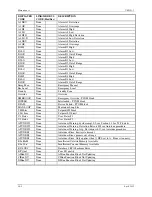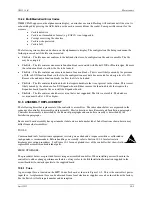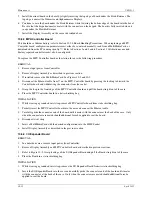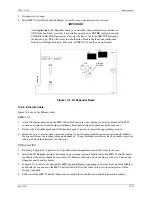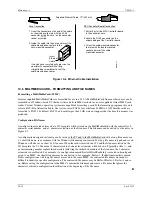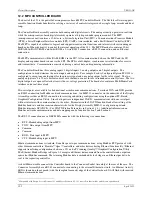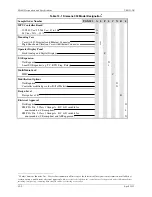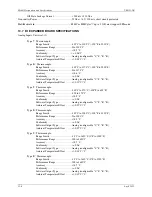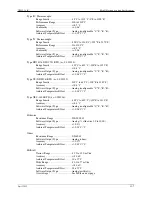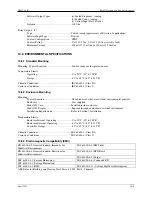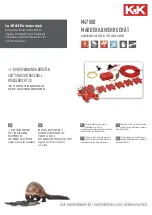
Circuit Description
UM353-1B
April
2012
12-2
12.2 MPU CONTROLLER BOARD
The heart of the 353 is the powerful, microprocessor-based MPU Controller Board. The flexible software supports
reusable function blocks beneficial in solving a vast array of control strategies such as single loop, cascade and dual
loop.
The Controller Board assembly contains both analog and digital circuits. The analog circuitry operates in real time
while the microprocessor based digital circuitry operates at high speed under program control. The MPU
(microprocessor unit) contains a 32-bit core, a System Integration Unit (SIU), a Communications Processor Module
(CPM), a Serial Peripheral Interface module (SPI), UARTs, timer modules, and a Fast Ethernet Controller (FEC).
The MPU is capable of arithmetic, logical, and support circuit control functions and interacts with surrounding on-
board and off-board circuitry to control the internal operation of the 353. The MPU Board also contains 32-bit
SDRAM, 16-Bit NVRAM, and 16-bit ROM, a 2-wire RS485 connection, a RS232 connection, and an Ethernet
connection.
The MPU communicates with the RAM, ROM via the SIU. All communication between the MPU and the I/O,
display and expander board is done via the SPI. The SPI is a full-duplex, synchronous serial interface for receive
and transmit data. Communication consists of timing, control, data, and sequencing information.
The Controller Board has three analog inputs, 3 digital inputs, 2 analog outputs and 2 digital outputs. The
configuration in use determines the active inputs and outputs. For example, Factory Configured Option FCO101 is
configured to accept one analog input for the process signal and one analog output for the valve signal. The two
analog outputs are 4 to 20 mA current sources with shutdown control for use in redundant control systems. The two
digital outputs are open collector devices with over-voltage protection. The board also contains a MultiMediaCard
interface and a real-time clock.
Two serial ports are available for bi-directional asynchronous communications. Terminals NCA and NCB provide
an RS485 connection for Modbus network communications. An MMJ-11 connector on the underside of the Display
Assembly provides an RS232 connection for creating and editing configurations using the optional PC-Based
Graphical Configuration Utility. Since both ports are independent UARTs, communications with one serial port
will not interfere with communications to the other. Parameters in the STATN function block allow setting of the
Modbus baud rate and transmission characteristic for the Display Assembly MMJ-11 configuration port and
Modbus terminals NCA/NCB. (See STATN-Station Parameters in Section 3.1.3.) Additional information on
Modbus network communications and data mapping can be found in Section 5 and Section 6.
The RS-232 connection uses a DEC MMJ connector with the following six connections:
•
RTS - Handshaking output from MPU
•
TXD - Data output from MPU
•
Common
•
Common
•
RXD - Data input to MPU
•
CTS - Handshaking input to MPU
Ethernet communications is standard. It enables peer-to-peer communications, using Modbus RTU protocol, with
other Siemens controllers, Procidia™ i|pac™ controllers, and other devices having Ethernet functionality.
3
Ethernet
supports transferring configurations between a 353 and a PC running i|config™ Graphical Configuration Utility.
The Ethernet-Modbus Bridge in Figure 1-2 accepts an Ethernet data command from the controller and outputs an
equivalent Modbus command. The returning Modbus data is embedded by the bridge in an Ethernet packet to be
sent to the requesting controller.
A short Ethernet cable connects the Controller board to the Connector Socket Assembly at the rear of the case. The
Connector Assembly has an RJ-45 connector for connecting to the external Ethernet network. An Ethernet Activity
LED is located on the exposed (with the faceplate loosened) edge of the Controller board. It will flash with received
Ethernet communications.
3
Compatible with Design Level A Siemens 353 and Moore Products Co. 353 controllers that include an Ethernet option board.
Summary of Contents for 353
Page 12: ...Contents UM353 1B x April 2012 ...
Page 22: ...Introduction UM353 1B April 2012 1 10 ...
Page 30: ...Configuration Overview UM353 1B April 2012 2 8 ...
Page 122: ...Function Blocks UM353 1B April 2012 3 92 ...
Page 168: ...Data Mapping UM353 1B April 2012 6 28 ...
Page 204: ...Controller and System Test UM353 1B April 2012 9 8 ...
Page 222: ...Calibration UM353 1B April 2012 11 4 ...
Page 226: ...Circuit Description UM353 1B April 2012 12 4 ...
Page 238: ...Model Designation and Specifications UM353 1B April 2012 13 12 EC Declaration of Conformity ...
Page 240: ...Model Designation and Specifications UM353 1B April 2012 13 14 ...
Page 244: ...Abbreviations And Acronyms UM353 1B 14 4 April 2012 ...



